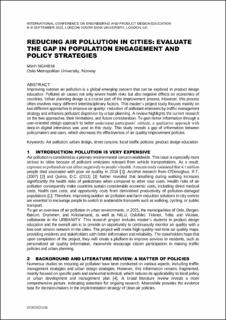Reducing air pollution in cities: Evaluate the gap in population engagement and policy strategies
Chapter, Peer reviewed
Published version

Åpne
Permanent lenke
https://hdl.handle.net/11250/3047019Utgivelsesdato
2022Metadata
Vis full innførselSamlinger
Sammendrag
Improving outdoor air pollution is a global emerging concern that can be explored in product design education. Polluted air causes not only severe health risks but also negative effects on economics of countries. Urban planning design is a crucial part of the improvement process. However, this process often involves many different interdisciplinary factors. This master’s project study focuses mainly on two different approaches to improve air quality: reduction of pollutant emissions by traffic management strategy and enhances pollutant dispersion by urban planning. A review highlights the current research on the two approaches, their limitations, and future consideration. To gain richer information through a user-oriented design approach to better understand participants’ attitude, a qualitative approach with deep-in digital interviews was used in this study. This study reveals a gap of information between policymakers and users, which decreases the effectiveness of air quality improvement policies. REDUCING AIR POLLUTION IN CITIES: EVALUATE THE GAP IN POPULATION ENGAGEMENT AND POLICY STRATEGIES